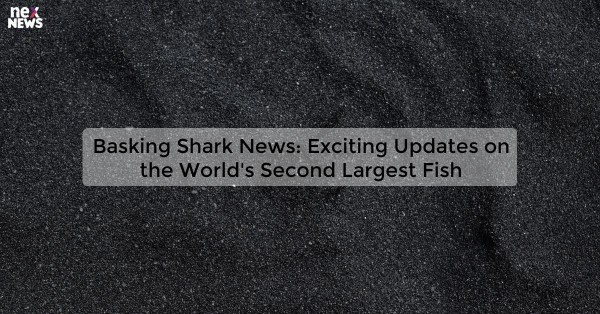What is a Basking Shark?
The Basking Shark is the second-largest fish in the world, after the Whale Shark. They are known for their massive size, reaching lengths of up to 40 feet and weighing as much as 5,000 pounds. Despite their intimidating appearance, Basking Sharks are gentle giants that feed primarily on plankton and small fish by filter-feeding. They can often be seen swimming near the surface with their enormous mouths wide open, filtering water to catch their food. Basking Sharks are found in temperate waters around the world, and are considered vulnerable due to threats such as bycatch and habitat degradation.
Basking Shark Habitat and Distribution
The basking shark is typically found in temperate and cool waters around the world, with populations found in the North Atlantic, North Pacific, and the southern hemisphere. They prefer coastal areas and are known to frequent areas with high concentrations of plankton, their primary food source. Basking sharks can be found at various depths, from the surface of the water to depths of up to 900 meters. They are known to migrate seasonally, with some populations moving to warmer waters in the winter months. Despite their wide distribution, basking sharks are considered vulnerable to extinction due to threats such as overfishing and habitat degradation.
Basking Shark Behavior and Feeding Habits
Basking sharks are known for their slow and gentle swimming behavior, often seen cruising near the surface with their mouths wide open to filter feed on plankton and small fish. These massive sharks can grow up to 40 feet in length and are the second-largest fish in the world. They are primarily solitary animals but may form small groups during feeding aggregations. Basking sharks have specialized gill rakers that help them efficiently filter out tiny organisms from the water as they swim with their mouths open. Despite their large size, basking sharks are considered harmless to humans as they are filter feeders and do not actively prey on larger animals.
Conservation Efforts for Basking Sharks
Conservation efforts for basking sharks primarily focus on research and monitoring to better understand their populations and movements. Basking sharks are listed as vulnerable by the International Union for Conservation of Nature (IUCN) due to threats such as bycatch in fisheries, habitat degradation, and vessel strikes. Efforts to protect them include implementing fishing regulations to reduce bycatch, establishing marine protected areas where they are known to frequent, and raising awareness about the importance of these gentle giants in marine ecosystems. Additionally, initiatives to track their movements through tagging and satellite technology are helping researchers to identify key habitats and migration routes, so that targeted conservation measures can be implemented to ensure the long-term survival of basking sharks.
Latest Research on Basking Shark Populations
Recent research on basking shark populations has shown that these gentle giants are facing significant threats to their survival. A study published in 2020 found that basking shark numbers have declined by over 90% in the Northeast Atlantic over the past 60 years, with only a few hundred individuals remaining in the region. The main threats to basking sharks include overfishing, habitat degradation, and climate change, which are driving populations towards extinction. Conservation efforts are urgently needed to protect these vulnerable creatures and ensure their long-term survival.
Basking Shark Sightings Around the World
Basking sharks, the second-largest fish in the world, have been spotted in various locations around the globe. In recent years, sightings have been reported off the coast of California, where these gentle giants have been spotted feeding on plankton. They have also been seen in the waters of the UK, particularly off the coast of Scotland, where they are known to migrate during the summer months. Basking sharks have been seen as far south as Australia and New Zealand, showcasing their ability to travel vast distances in search of food. These sightings highlight the importance of protecting these magnificent creatures and their habitats to ensure their continued presence in our oceans.
Basking Shark Biology and Anatomy
The basking shark (Cetorhinus maximus) is the second-largest fish in the world, with adults typically reaching lengths of 20-26 feet. These gentle giants are filter feeders, primarily consuming plankton and small fish by swimming with their mouths open to collect food. They have a unique anatomy that includes a large, gaping mouth that can open up to three feet wide, allowing them to filter large amounts of water to extract their tiny prey. Basking sharks also have a distinctive dorsal fin that is located towards the rear of their body, as well as a caudal fin that is crescent-shaped. Their bodies are covered in tiny, dermal denticles that give them a rough texture, similar to sandpaper.
Threats Facing Basking Sharks
Basking sharks face numerous threats that have led to a decline in their population. These threats include habitat destruction, as their feeding grounds and migration routes are being disrupted by human activities such as coastal development and fishing. They are also at risk of entanglement in fishing gear, as they are often caught accidentally in nets meant for other species. Additionally, basking sharks are targeted for their fins, liver oil, and meat, making them vulnerable to overexploitation. Climate change is also a threat, as it is altering ocean temperatures and disrupting the availability of their prey. All of these factors combined pose a serious threat to the survival of basking sharks.
How to Spot a Basking Shark in the Wild
Spotting a basking shark in the wild can be an exhilarating experience, but it can also be challenging since they are often mistaken for other large marine species. One key characteristic to look out for is their massive size, as basking sharks can grow up to 40 feet long, making them one of the largest shark species in the world. Additionally, their distinctive dorsal and caudal fins are much larger in proportion to their body compared to other sharks. Basking sharks are also known for their slow, graceful movements near the surface of the water as they filter feed on plankton, so keep an eye out for their distinctive behavior when trying to spot them in their natural habitat.
Basking Shark Tourism and Ecotourism Opportunities
Basking sharks are gentle giants of the sea that migrate to coastal waters during the summer months, providing an excellent opportunity for ecotourism and wildlife viewing. Tourists can embark on boat trips to observe these majestic creatures up close, learning about their behavior, habitat, and conservation status from knowledgeable guides. This sustainable form of tourism not only supports local economies but also raises awareness about the importance of protecting these vulnerable species and their marine ecosystems. By promoting responsible interactions with basking sharks, ecotourism can contribute to their long-term conservation while providing unforgettable and educational experiences for visitors.

